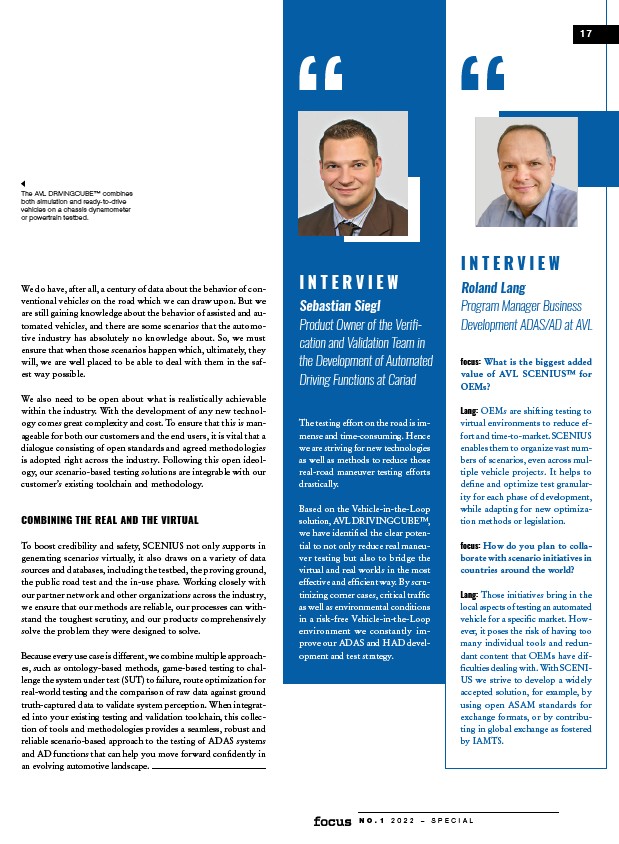
“ “
I N T E R V I E W
Roland Lang
Program Manager Business
Development ADAS/AD at AVL
I N T E R V I E W
Sebastian Siegl
Product Owner of the Verifi-cation
and Validation Team in
the Development of Automated
Driving Functions at Cariad
focus: What is the biggest added
value of AVL SCENIUS™ for
OEMs?
Lang: OEMs are shifting testing to
virtual environments to reduce ef-fort
and time-to-market. SCENIUS
enables them to organize vast num-bers
of scenarios, even across mul-tiple
vehicle projects. It helps to
define and optimize test granular-ity
for each phase of development,
while adapting for new optimiza-tion
methods or legislation.
focus: How do you plan to colla-borate
with scenario initiatives in
countries around the world?
Lang: Those initiatives bring in the
local aspects of testing an automated
vehicle for a specific market. How-ever,
it poses the risk of having too
many individual tools and redun-dant
content that OEMs have dif-ficulties
dealing with. With SCENI-US
we strive to develop a widely
accepted solution, for example, by
using open ASAM standards for
exchange formats, or by contribu-ting
in global exchange as fostered
by IAMTS.
The testing effort on the road is im-mense
and time-consuming. Hence
we are striving for new technologies
as well as methods to reduce those
real-road maneuver testing efforts
drastically.
Based on the Vehicle-in-the-Loop
solution, AVL DRIVINGCUBE™,
we have identified the clear poten-tial
to not only reduce real maneu-ver
testing but also to bridge the
virtual and real worlds in the most
effective and efficient way. By scru-tinizing
corner cases, critical traffic
as well as environmental conditions
in a risk-free Vehicle-in-the-Loop
environment we constantly im-prove
our ADAS and HAD devel-opment
and test strategy.
1 7
N O . 1 2 0 2 2 – S P E C I A L
The AVL DRIVINGCUBE™ combines
both simulation and ready-to-drive
vehicles on a chassis dynamometer
or powertrain testbed.
We do have, after all, a century of data about the behavior of con-ventional
vehicles on the road which we can draw upon. But we
are still gaining knowledge about the behavior of assisted and au-tomated
vehicles, and there are some scenarios that the automo-tive
industry has absolutely no knowledge about. So, we must
ensure that when those scenarios happen which, ultimately, they
will, we are well placed to be able to deal with them in the saf-est
way possible.
We also need to be open about what is realistically achievable
within the industry. With the development of any new technol-ogy
comes great complexity and cost. To ensure that this is man-ageable
for both our customers and the end users, it is vital that a
dialogue consisting of open standards and agreed methodologies
is adopted right across the industry. Following this open ideol-ogy,
our scenario-based testing solutions are integrable with our
customer’s existing toolchain and methodology.
COMBINING THE REAL AND THE VIRTUAL
To boost credibility and safety, SCENIUS not only supports in
generating scenarios virtually, it also draws on a variety of data
sources and databases, including the testbed, the proving ground,
the public road test and the in-use phase. Working closely with
our partner network and other organizations across the industry,
we ensure that our methods are reliable, our processes can with-stand
the toughest scrutiny, and our products comprehensively
solve the problem they were designed to solve.
Because every use case is different, we combine multiple approach-es,
such as ontology-based methods, game-based testing to chal-lenge
the system under test (SUT) to failure, route optimization for
real-world testing and the comparison of raw data against ground
truth-captured data to validate system perception. When integrat-ed
into your existing testing and validation toolchain, this collec-tion
of tools and methodologies provides a seamless, robust and
reliable scenario-based approach to the testing of ADAS systems
and AD functions that can help you move forward confidently in
an evolving automotive landscape.